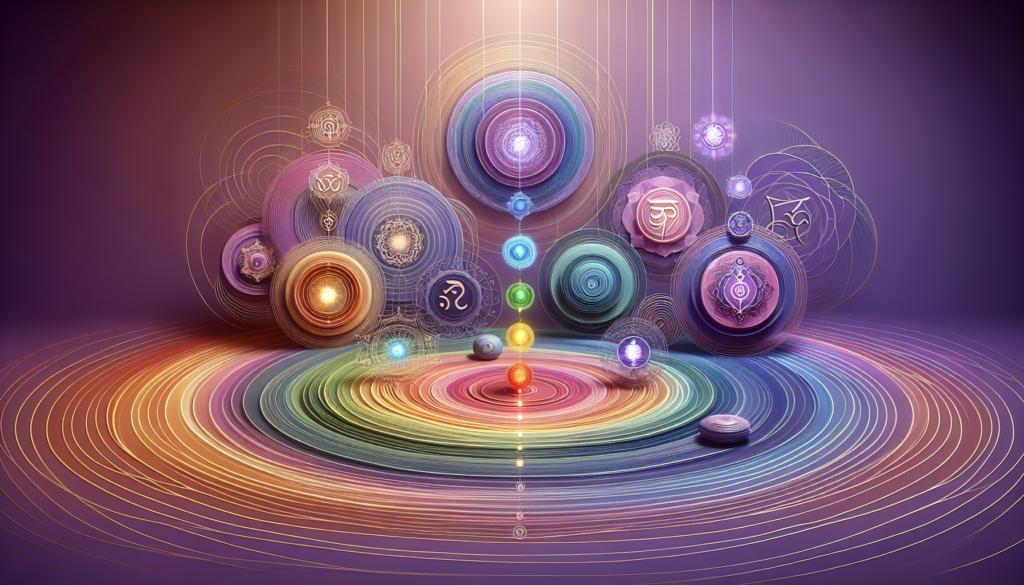You know how important it is to take care of your body and mind, but have you ever considered the energy within you? In this article, we will explore the fascinating world of chakras and their profound impact on your overall wellbeing. By understanding and balancing these energy centers, you can unlock a renewed sense of vitality and harmony in your life. Whether you’re curious about the basics or eager to dive deeper into the intricate workings of chakras, this article is your friendly guide to achieving optimal balance and serenity. Get ready to embark on a transformative journey towards a more balanced and grounded existence.
What are Chakras?
Chakras are vital energy centers within our body that play a crucial role in our overall wellbeing. Derived from the Sanskrit word meaning “wheel,” chakras are believed to be spinning wheels of energy that correspond to different areas of our physical, emotional, and spiritual selves. Understanding and balancing the seven main chakras can lead to a more harmonious and balanced life.
Definition of Chakras
Chakras can be defined as the invisible, circular spinning energy centers that are aligned along the spine, starting from the base and ascending to the crown of the head. Each chakra is associated with specific qualities and functions, and when these chakras are balanced, the energy flows freely, resulting in a sense of overall wellbeing.
Understanding the Seven Main Chakras
The seven main chakras, also known as the energy centers, are located along the spine and are associated with specific colors, elements, sounds, and qualities. Understanding these chakras is essential in order to effectively balance and harmonize them. The seven main chakras are:
- Root Chakra (Muladhara) – Represents grounding, stability, and basic survival instincts.
- Sacral Chakra (Svadhisthana) – Associated with creativity, sexuality, and emotional balance.
- Solar Plexus Chakra (Manipura) – Governs self-esteem, personal power, and motivation.
- Heart Chakra (Anahata) – Relates to love, compassion, gratitude, and emotional healing.
- Throat Chakra (Vishuddha) – Deals with communication, self-expression, and speaking one’s truth.
- Third Eye Chakra (Ajna) – Associated with intuition, imagination, and spiritual awareness.
- Crown Chakra (Sahasrara) – Represents higher consciousness, connection to the divine, and spiritual enlightenment.
Importance of Balancing Chakras
The Impact of Imbalanced Chakras on Overall Wellbeing
When the chakras are imbalanced, they can lead to various physical, emotional, and spiritual issues. For example, an imbalance in the root chakra may result in feelings of insecurity or instability, while an imbalanced throat chakra can manifest as difficulty in expressing oneself or fear of judgment. It is important to address these imbalances to maintain overall wellbeing.
Benefits of Balancing Chakras
Balancing chakras can have a profound impact on our physical, emotional, and spiritual health. Some of the benefits of balancing chakras include better physical health, increased energy and vitality, improved mental clarity and focus, enhanced emotional stability, heightened spiritual awareness, and a greater sense of peace and harmony within oneself.

Detecting Chakra Imbalances
Signs and Symptoms of Chakra Imbalance
Detecting chakra imbalances is crucial in order to address and restore harmony to these energy centers. Some common signs and symptoms of chakra imbalance include physical ailments such as chronic pain, digestive issues, and fatigue, as well as emotional disturbances like anxiety, depression, and mood swings. Additionally, recurring patterns of negative thoughts, relationship difficulties, and a lack of creativity may also indicate chakra imbalances.
Tools and Techniques for Identifying Chakra Imbalances
There are various tools and techniques available to help identify chakra imbalances. Some commonly used methods include energy healing practices such as Reiki or acupuncture, where practitioners can detect blockages or imbalances in the chakras. Other techniques include working with a knowledgeable energy healer or using self-assessment tools such as chakra questionnaires or guided meditation sessions specifically focused on chakra awareness.
Techniques for Balancing Chakras
Meditation and Visualization
Meditation and visualization are powerful techniques for balancing and aligning the chakras. By focusing your attention on each chakra and visualizing them spinning or radiating their associated color, you can bring awareness and energy to that particular energy center. Regular practice of chakra meditation can help remove any energetic blockages, restore balance, and enhance the flow of energy throughout your body.
Breathing Exercises
Breathing exercises, such as pranayama, can also help balance the chakras. By intentionally controlling the breath, you can direct prana (life force energy) to specific chakras, clearing any blockages and promoting balance. Alternate nostril breathing, deep belly breathing, and the kapalabhati breath are just a few examples of breathing exercises that can aid in chakra balancing.
Energy Healing Modalities
Energy healing modalities, like Reiki, acupuncture, or sound healing, can be incredibly effective in balancing the chakras. These modalities work by clearing any energetic blockages, promoting the flow of energy, and restoring balance to the chakras. Seek out certified practitioners who specialize in these modalities for a tailored and professional chakra balancing experience.
Color and Sound Therapy
Color and sound therapy are powerful tools for balancing chakras. Each chakra is associated with a specific color and sound frequency that resonates with its energetic vibration. Surrounding yourself with the appropriate color or listening to music or sounds that correspond to the chakra can help restore balance. For example, using red objects or listening to music in the key of C can aid in balancing the root chakra.

Root Chakra Balancing
Understanding the Root Chakra
The root chakra, also known as the Muladhara chakra, is located at the base of the spine. It is associated with the color red, the element of earth, and qualities such as stability, grounding, and survival instincts. Balancing the root chakra is essential for a solid foundation and a sense of security in one’s physical existence.
Techniques for Balancing the Root Chakra
Several techniques can help balance the root chakra. Engaging in physical activities such as walking barefoot on the earth, practicing yoga postures that focus on the lower body, or surrounding yourself with the color red can help restore balance. Additionally, using grounding crystals, such as hematite or red jasper, can aid in balancing the root chakra.
Sacral Chakra Balancing
Understanding the Sacral Chakra
The sacral chakra, known as the Svadhisthana chakra, is located in the lower abdomen, just below the navel. This chakra is associated with the color orange, the element of water, and is connected to creativity, sexuality, and emotional balance. Balancing the sacral chakra is essential for embracing pleasure, cultivating creativity, and maintaining healthy relationships.
Techniques for Balancing the Sacral Chakra
To balance the sacral chakra, engaging in activities that promote creativity, such as painting, dancing, or playing a musical instrument, can be beneficial. Additionally, practicing yoga poses that activate the pelvic area, such as hip openers, can help restore balance. Using orange-colored crystals, like carnelian or orange calcite, can also aid in sacral chakra balancing.
Solar Plexus Chakra Balancing
Understanding the Solar Plexus Chakra
The solar plexus chakra, known as the Manipura chakra, is located above the navel and is associated with the color yellow and the element of fire. This chakra governs self-esteem, personal power, and motivation. Balancing the solar plexus chakra is crucial for developing a strong sense of self and maintaining a healthy level of confidence.
Techniques for Balancing the Solar Plexus Chakra
To balance the solar plexus chakra, engaging in activities that promote personal power and self-confidence, such as affirmations or setting and achieving goals, can be helpful. Participating in activities that stimulate the fire element, such as practicing martial arts or spending time in the sun, can also aid in restoring balance. Using yellow crystals, like citrine or yellow tiger’s eye, can further support solar plexus chakra balancing.
Heart Chakra Balancing
Understanding the Heart Chakra
The heart chakra, known as the Anahata chakra, is located in the center of the chest and is associated with the color green or pink. This chakra represents love, compassion, gratitude, and emotional healing. Balancing the heart chakra is crucial for fostering harmonious relationships, self-love, and overall emotional well-being.
Techniques for Balancing the Heart Chakra
Practicing acts of kindness, expressing gratitude, and engaging in heart-opening yoga poses, such as camel pose or bridge pose, can help balance the heart chakra. Using green or pink crystals, like rose quartz or green aventurine, can also assist in restoring balance to this energy center. Additionally, practicing loving-kindness meditation or engaging in heart-centered visualization exercises can further support heart chakra balancing.
Throat Chakra Balancing
Understanding the Throat Chakra
The throat chakra, known as Vishuddha, is located at the throat region and is associated with the color blue. This chakra is related to communication, self-expression, and speaking one’s truth. Balancing the throat chakra is crucial for clear and authentic communication, as well as for expressing oneself freely and honestly.
Techniques for Balancing the Throat Chakra
To balance the throat chakra, engaging in activities that promote self-expression, such as writing, singing, or engaging in open and honest conversations, can be beneficial. Practicing specific throat chakra-opening yoga postures, like fish pose or lion pose, can also assist in restoring balance. Using blue crystals, such as aquamarine or lapis lazuli, can further support throat chakra balancing.
Maintaining Balanced Chakras
Regular Self-Care Practices
Maintaining balanced chakras requires regular self-care practices. Engaging in activities that nourish your mind, body, and spirit, such as meditation, exercise, healthy eating, and spending time in nature, can help keep your chakras in harmony. Practicing mindfulness and being aware of your energetic state can also contribute to maintaining balanced chakras.
Seeking Professional Guidance
Seeking professional guidance from energy healers, holistic practitioners, or chakra experts can provide valuable support in maintaining balanced chakras. These professionals can offer personalized advice, energy healing sessions, or chakra assessments to help restore and maintain harmony within your chakra system.
Consistency and Patience
Balancing chakras is a journey that requires consistency and patience. Just as it takes time for imbalances to manifest, it will also take time to restore balance. Be patient with yourself and trust the process. Consistently engaging in chakra-balancing practices and staying committed to your wellbeing will yield long-term benefits and help you maintain balanced chakras.
In conclusion, balancing chakras is a powerful way to enhance your overall wellbeing. By understanding the seven main chakras, detecting imbalances, and using various techniques for balancing, you can experience profound transformation and live a more harmonious and fulfilling life. Remember to be consistent, seek professional guidance when needed, and practice regular self-care to maintain balanced chakras and thrive on all levels.

